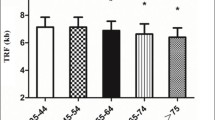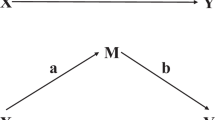Abstract
Few reports have investigated the predictive value of urinary cadmium (UCd) and telomere length on renal function impairment. Therefore, we constructed nomogram models, using a cross-sectional survey to analyze the potential function of UCd and telomere length in renal function impairment risk. We randomly selected two community populations in Shanxi, China, and general information of the subjects was collected through face-to-face questionnaire surveys. Venous blood of subjects was collected to detect absolute telomere length (ATL) by real-time quantitative chain reaction (RT-PCR). Collecting urinary samples detected UCd and urinary N-acetyl-β-d-glucosaminidase (UNAG). Estimated glomerular filtration rate (eGFR) was obtained based on serum creatinine (SCr). Nomogram models on risk prediction analysis of renal function impairment was constructed. After adjusting for other confounding factors, UCd (β = 0.853, 95% confidence interval (CI): 0.739 ~ 0.986) and ATL (β = 1.803, 95%CI: 1.017 ~ 1.154) were independent risk influencing factors for increased UNAG levels, and the risk factors for eGFR reduction were UCd (β = 1.011, 95%CI: 1.187 ~ 1.471), age (β = 1.630, 95%CI: 1.303 ~ 2.038), and sex (β = 0.181, 95%CI: 0.105 ~ 0.310). Using UCd, ATL, sex, and age to construct the nomogram, and the C-statistics 0.584 (95%CI: 0.536 ~ 0.632) and 0.816 (95%CI: 0.781 ~ 0.851) were obtained by internal verification of the calibration curve, C-statistics revealed nomogram model validation was good and using decision curve analysis (DCA) confirmed a good predictive value of the nomogram models. In a nomogram model, ATL, UCd, sex, and age were detected as independent risk factors for renal function impairment, with UCd being the strongest predictor.





Similar content being viewed by others
References
Ameh OI, Okpechi IG, Dandara C, Kengne A-P (2017) Association between telomere length, chronic kidney disease, and renal traits: a systematic review. Omi a J Integr Biol 21:143–155
Balachandran VP, Gonen M, Smith JJ, DeMatteo RP (2015) Nomograms in oncology: more than meets the eye. Lancet Oncol 16:e173–e180
Blanco Muñoz J, Lope V, Fernández de Larrea-Baz N et al (2022) Levels and determinants of urinary cadmium in general population in Spain: Metal-MCC-Spain study. Environ Res 210:112959
Blasco MA (2005) Telomeres and human disease: ageing, cancer and beyond. Nat Rev Genet 6:611–622
Bonnell JA, Ross JH, King E (1960) Renal lesions in experimental cadmium poisoning. Occup Environ Med 17:69–80
Canela A, Klatt P, Blasco MA (2007) Telomere length analysis. Methods Mol Biol 371:45–72
Chen X, Chen X, Wang X et al (2021) The association between estimated glomerular filtration rate and cadmium exposure: an 8-year follow-up study. Int J Hyg Environ Health 235:113774
Chen X, Chen X, Wang Y et al (2020) A nomogram for predicting the renal dysfunction in a Chinese population with reduction in cadmium exposure based on an 8 years follow up study. Ecotoxicol Environ Saf 191:110251
Cheng F, Luk AO, Wu H et al (2021) Relative leucocyte telomere length is associated with incident end-stage kidney disease and rapid decline of kidney function in type 2 diabetes: analysis from the Hong Kong Diabetes Register. Diabetologia 65:375–386
Chung S, Chung JH, Kim SJ et al (2014) Blood lead and cadmium levels and renal function in Korean adults. Clin Exp Nephrol 18:726–734
Cohen J (1977) Chapter 2 - The t test for means. In: Cohen J (ed) Statistical power analysis for the behavioral sciences. Academic Press, pp 19–74
Ding X, Zhang Q, Wei H, Zhang Z (2011) Cadmium-induced renal tubular dysfunction in a group of welders. Occup Med (chic Ill) 61:277–279
Ferraro PM, Costanzi S, Naticchia A et al (2010) Low level exposure to cadmium increases the risk of chronic kidney disease: analysis of the NHANES 1999–2006. BMC Public Health 10:304
Filipits M, Dubsky P, Rudas M et al (2019) Prediction of distant recurrence using EndoPredict among women with ER+, HER2− node-positive and node-negative breast cancer treated with endocrine therapy only. Clin Cancer Res 25:3865–3872
Fillman T, Shimizu-Furusawa H, Ng CFS et al (2016) Association of cadmium and arsenic exposure with salivary telomere length in adolescents in Terai. Nepal Environ Res 149:8–14
Fong Y (2019) Textbook outcome nomograms as multivariate clinical tools for building cancer treatment pathways and prognosticating outcomes. JAMA Surg 154:e190572–e190572
Grau-Perez M, Zhao J, Pierce B et al (2018) Urinary metals and leukocyte telomere length in American Indian communities: the Strong Heart and the Strong Heart Family Study. Environ Pollut 246:311–318
Hecht EM, Arheart K, Lee DJ et al (2016) A cross-sectional survey of cadmium biomarkers and cigarette smoking. Biomarkers 21:429–435
Iasonos A, Schrag D, Raj GV, Panageas KS (2008) How to build and interpret a nomogram for cancer prognosis. J Clin Oncol 26:1364–1370
Järup L, Hellström L, Alfvén T et al (2000) Low level exposure to cadmium and early kidney damage: the OSCAR study. Occup Environ Med 57:668–672
Jean J, Sirot, et al (2018) Dietary exposure to cadmium and health risk assessment in children - results of the French infant total diet study. Food Chem Toxicol an Int J Publ Br Ind Biol Res 115:358–364
Jin T, Kong Q, Ye T et al (2004) Renal dysfunction of cadmium-exposed workers residing in a cadmium-polluted environment. Biometals 17:513–518
Jin T, Nordberg M, Frech W et al (2002) Cadmium biomonitoring and renal dysfunction among a population environmentally exposed to cadmium from smelting in China (ChinaCad). Biometals 15:397–410
Kattan MW, Marasco J (2010) What is a real nomogram? Semin Oncol 37:23–26
Levey AS, Bosch JP, Lewis JB et al (1999) A more accurate method to estimate glomerular filtration rate from serum creatinine: a new prediction equation. Modification of Diet in Renal Disease Study Group. Ann Intern Med 130:461–470
Levey AS, Josef C, Tom G et al (2006) Using standardized serum creatinine values in the modification of diet in renal disease study equation for estimating glomerular filtration rate. Ann Intern Med 145:247–254
Liang Y, Lei L, Nilsson J et al (2012) Renal function after reduction in cadmium exposure: an 8-year follow-up of residents in cadmium-polluted areas. Environ Health Perspect 120:223–228
Madrim MF, Ja’afar MH, Hod R, (2021) Prevalence of abnormal urinary cadmium and risk of albuminuria as a primary bioindicator for kidney problems among a healthy population. PeerJ 9:e12014
Mizuno Y, Konishi S, Imai H et al (2019) Cadmium exposure and blood telomere length in female university students in Japan. Biol Trace Elem Res 192:98–105
Morais M, Dias F, Teixeira AL, Medeiros R (2020) Telomere length in renal cell carcinoma: the Jekyll and Hyde biomarker of ageing of the kidney. Cancer Manag Res 12:1669
Navas-Acien A, Tellez-Plaza M, Guallar E et al (2009) Blood cadmium and lead and chronic kidney disease in US adults: a joint analysis. Am J Epidemiol 170:1156–1164
Orlowski C, Piotrowski JK, Subdys JK, Gross A (1998) Urinary cadmium as indicator of renal cadmium in humans: an autopsy study. Hum Exp Toxicol 17:302–306
Park S, Lee S, Kim Y et al (2021) A Mendelian randomization study found causal linkage between telomere attrition and chronic kidney disease. Kidney Int 100:1063–1070
Rani A, Kumar A, Lal A, Pant M (2014) Cellular mechanisms of cadmium-induced toxicity: a review. Int J Environ Health Res 24:378–399
Raschenberger J, Kollerits B, Ritchie J et al (2015) Association of relative telomere length with progression of chronic kidney disease in two cohorts: effect modification by smoking and diabetes. Sci Rep 5:1–8
Repić A, Bulat P, Antonijević B et al (2020) The influence of smoking habits on cadmium and lead blood levels in the Serbian adult people. Environ Sci Pollut Res 27:751–760
Rh A, Ws B, Mn C et al (2010) Cadmium induced renal dysfunction among residents of rice farming area downstream from a zinc-mineralized belt in Thailand. Toxicol Lett 198:26–32
Satarug S (2018) Dietary cadmium intake and its effects on kidneys. Toxics 6:15
Satarug S, Baker JR, Urbenjapol S et al (2003) A global perspective on cadmium pollution and toxicity in non-occupationally exposed population. Toxicol Lett 137:65–83
Satarug S, Garrett SH, Sens MA, Sens DA (2010) Cadmium, environmental exposure, and health outcomes. Environ Health Perspect 118:182–190
Satarug S, Moore MR (2004) Adverse health effects of chronic exposure to low-level cadmium in foodstuffs and cigarette smoke. Environ Health Perspect 112:1099–1103
Satarug S, Swaddiwudhipong W, Ruangyuttikarn W et al (2013) Modeling cadmium exposures in low- and high-exposure areas in Thailand. Environ Health Perspect 121:531–536
Shi Z, Taylor AW, Riley M et al (2018) Cadmium intake and chronic kidney disease: response to Kawada T. Clin Nutr 37:1774
Thornton I (1992) Sources and pathways of cadmium in the environment. IARC Sci Publ 149–162
Trzeciakowski JP, Gardiner L, Parrish AR (2014) Effects of environmental levels of cadmium, lead and mercury on human renal function evaluated by structural equation modeling. Toxicol Lett 228:34–41
Van Calster B, Wynants L, Verbeek JFM et al (2018) Reporting and interpreting decision curve analysis: a guide for investigators. Eur Urol 74:796–804
van der Harst P, Wong LSM, de Boer RA et al (2008) Possible association between telomere length and renal dysfunction in patients with chronic heart failure. Am J Cardiol 102:207–210
Wai KM, Umezaki M, Kosaka S et al (2018) Impact of prenatal heavy metal exposure on newborn leucocyte telomere length: a birth-cohort study. Environ Pollut 243:1414–1421
Wang D, Sun H, Wu Y et al (2016) Tubular and glomerular kidney effects in the Chinese general population with low environmental cadmium exposure. Chemosphere 147:3–8
Wong LS, Windt WA, Roks AJ et al (2009) Renal failure induces telomere shortening in the rat heart. Netherlands Hear J 17:190–194
Yang H-C, Fogo AB (2014) Fibrosis and renal aging. Kidney Int Suppl 4:75–78
Zhang L, Song L, Liu B et al (2019) Prenatal cadmium exposure is associated with shorter leukocyte telomere length in Chinese newborns. BMC Med 17:1–8
Zhang Y, Xu X, Chen A et al (2018) Maternal urinary cadmium levels during pregnancy associated with risk of sex-dependent birth outcomes from an e-waste pollution site in China. Reprod Toxicol 75:49–55
Zota AR, Needham BL, Blackburn EH et al (2015) Associations of cadmium and lead exposure with leukocyte telomere length: findings from National Health and Nutrition Examination Survey, 1999–2002. Am J Epidemiol 181:127–136
Acknowledgements
We would like to thank all research subjects for their participation and thank for the strong support from the National Natural Science Foundation of China (81872701, 81273040).
Funding
This study was supported by the National Natural Science Foundation of China (81872701, 81273040).
Author information
Authors and Affiliations
Contributions
Li-Jian Lei designed the study. Jia-Chen Zhang and Shuang-Jing Li analyzed the data and drafted the manuscript; Li-Jian Lei revised the manuscript. Jian-Yong Guo, Guo-Yan Zhang, Hui Kang, Xiu-Jing Shi, Han Zhou, Yu-Fen Liang, and Wei-Tong Shen contributed to collecting the data. Jia-Chen Zhang and Shuang-Jing Li had the same contribution to this research. All authors read and approved the final manuscript.
Corresponding author
Ethics declarations
Ethics approval
The research design was approved by the Ethical Review Committee of Shanxi Medical University.
Consent to participate
Subject’s consent has been obtained.
Consent for publication
Not applicable.
Competing interests
The authors declare no competing interests.
Additional information
Responsible Editor: Lotfi Aleya
Publisher's note
Springer Nature remains neutral with regard to jurisdictional claims in published maps and institutional affiliations.
Supplementary Information
Below is the link to the electronic supplementary material.
Rights and permissions
About this article
Cite this article
Zhang, JC., Li, SJ., Guo, JY. et al. Urinary cadmium and peripheral blood telomere length predict the risk of renal function impairment: a study of 547 community residents of Shanxi, China. Environ Sci Pollut Res 29, 71427–71438 (2022). https://doi.org/10.1007/s11356-022-20923-6
Received:
Accepted:
Published:
Issue Date:
DOI: https://doi.org/10.1007/s11356-022-20923-6




